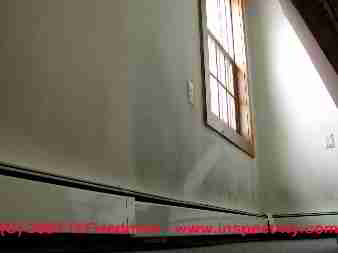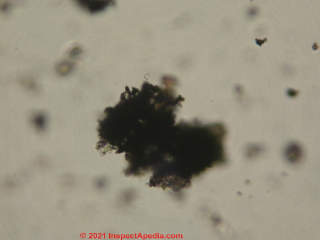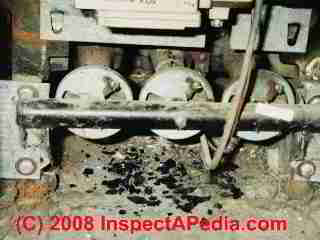 Soot Hazards in Buildings
Soot Hazards in Buildings
Breathing soot is unsafe & soot on surfaces might indicate dangerous building conditions
- POST a QUESTION or COMMENT about this the dangers of airborne soot and even the implications of soot deposits indoors
This article describes health and safety concerns for people in buildings where there is visible soot that may be traced to gas appliances, fireplaces, oil burners, or other sources.
We also discuss best DIY methods for cleaning up soot deposits on building surfaces and materials.
Watch out: if your gas fueled heater or appliance is producing soot it may also be releasing fatal carbon monoxide gas. Turn off suspect equipment and be sure you have working smoke and CO Carbon Monoxide detectors in your building.
InspectAPedia tolerates no conflicts of interest. We have no relationship with advertisers, products, or services discussed at this website.
- Daniel Friedman, Publisher/Editor/Author - See WHO ARE WE?
Are Soot or Soot Stains in Buildings Dangerous?
are a serious health hazard that, at 2021 U.S. standards for allowable exposure to airborne soot (12 mcg/L), is associated with 45,000 deaths a year in that country alone.
Because of their small size, in the 2.5 micron range, soot particles are breathed deeply into the lungs and are contributors to respiratory illness, strokes, and heart attacks. Airborne soot is a particular concern in urban areas and particularly affects black and brown communities whose housing tends to be closer to soot-producing industrial areas.
In 2021 the US EPA plans to review its standards for allowable airborne soot exposure. Experts note that if the allowable soot level were dropped from its present 12 mcg/L down to 9 mcg/L the result would cut soot-related deaths in the U.S. by about 12,150 each year. - NY Times, 11 June 2012
Visible soot deposits:
Here, however, we address a less-widely-understood soot hazard: the presence of visible soot or soot deposits in building.
Dark sooty stains on ceilings, walls, or other surfaces may indicate unsafe heating equipment, a more-immediate hazard, or it might indicate other troublesome building conditions that are not safety hazards such as poor insulation, air leaks, or high moisture levels.
Unsafe heating equipment:
Above we warned about sooting gas fueled heaters - that can be quite dangerous because it indicates unsafe heater operation, risking both fatal carbon monoxide poisoning from malfunctioning gas heaters.
Similarly dangerous, a soot-producing oil burner offers the risk of a dangerous oil burner puffback explosion.
Building insulation, air leaks, moisture levels:
Soot or dark ghosting stains on building ceilings and walls may not, however originate with heating equipment but might instead tell us about faults in the building's insulation, air leakiness, and indoor moisture.
All three of those, in turn, speak to building comfort, heating and cooling costs, and to more subtle hazards like moisture-related hidden mold contamination.
Photo: severe dark ghosting stains or "thermal tracking" on building walls.
[Click to enlarge any image]
Sooty dark indoor stains may be due to more normal building activities: smoking, use of scented candles, dusty pets, even sooty outdoor air in some cities.
Watch out: also from HUD, cited below:
Smoke, soot and ash are serious health hazards.
Ash can act as a skin irritant. Soot particles can float in the air and are an irritant to the respiratory system.
Oily soot can contain toxins. As the heat of a fire increases, soot becomes pressurized and forced into small cracks, crevices and into surface finishes.
Smoke, soot and ash stain materials and can become trapped in window tracks, gutters, insulation, air conditioner equipment, vents, ducts and exterior drains.
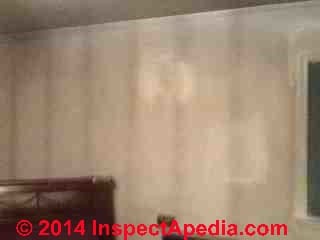 Really? Well, no. Not necessarily. While heavy indoor soot deposits from any source and oil burner soot particles in particular may be hazardous, that does NOT mean that typical light soot deposits such as those that map wall studs or ceiling joists are themselves capable of releasing enough particles into indoor air as to form a hazard.
Really? Well, no. Not necessarily. While heavy indoor soot deposits from any source and oil burner soot particles in particular may be hazardous, that does NOT mean that typical light soot deposits such as those that map wall studs or ceiling joists are themselves capable of releasing enough particles into indoor air as to form a hazard.
See details at GHOSTING DARK STREAKS or LINES: CAUSES to diagnose lines or rectangular areas of stains on walls or ceilings
But Watch out: if you're seeing heavy soot deposits like those shown above, and if you've not already found and fixed the cause of that sooting on walls or ceilings, there could be very dangerous conditions in your building such as
- A gas burner that is not working properly,
producing soot and also dangerous carbon monoxide - An oil burner that is not working properly,
risking a dangerous puffback explosion.
See details at
- GAS BURNER FLAME & NOISE DEFECTS
- GAS BURNER SOOT CAUSE & CURE
- GAS BURNER PILOT LIGHT PROCEDURE
- OIL BURNER SOOT & PUFFBACKS
Reader Question: are ghosting stains from a woodstove dangerous to building occupants?
Relating to “ghosting” from a woodstove seen on walls in house, is there reason to think this may present a health hazard to occupants?
The ghosting in our house cannot be smelled (unlike some houses of cigarette smokers), so was curious about wood smoke. I’ve repainted stove room and no issue with any stains bleeding through.
I’ve since put in an air purifier with HEPA filter in stove room and am considering a MERV 13 filter in box fan.
I may have to raise height of chimney as well. I realize that it’s site unseen, but curious what you think in general about the health piece.
This Q&A were posted originally
Moderator reply: stains on the walls are probably not harmful but look further at building conditions
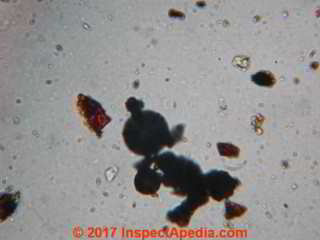 Thank you for the helpful ghosting stains vs soot hazards question.
Thank you for the helpful ghosting stains vs soot hazards question.
Photo: particle analysis n our forensic laboratory; those round black spheres of two sizes might be soot but as you'll see below, products of combustion often produce light, irregularly-shaped soot particulates. Top-lighting and more examination of these particles would be needed to complete identification.
There is ample research document in health hazards and air quality concerns with soot is airborne and thus breathed by people or other animals.
Soot particles are extremely fine, can pass deeply into the lung, and may be difficult to expel. Some of the citations I offer below document the health hazards of exposure to airborne soot and also describe the complexity of its chemistry and thus its variable effects.
Watch out: like many other environmental contaminants, soot particles don't affect everyone the same. Some people are more vulnerable, eg. children, the elderly, immune impaired (Bearer 1995) (Shriver 2009).
My OPINION about the health hazard from ghosting stains themselves is that it's not likely that such a hazard is detectable - meaning it's probably absent.
That is to say, once the building air no longer sports airborne soot particles, either having been adequately filtered or adequately provided by clean fresh outdoor air, we wouldn't expect there to be a hazardous level of airborne soot, and we wouldn't expect to be able to detect any meaningful level of airborne soot that was in fact attributable to those particles of soot that have become stuck-to or "plated" onto walls and ceilings where they form ghosting stains.
In sum, if you see the ghosting stain you know the soot particles have stuck to that surface. Those particular particles are not airborne.
Watch out: however if no one has identified and cured the *source* of indoor soot that has stained walls and ceilings the building could be in a very dangerous condition, particularly if sooting is coming not from a woodstove but from a malfunctioning gas-fired appliance.
The same conditions that produce gas-appliance soot are likely to be producing potentially fatal carbon monoxide gas.
Be sure your building has properly installed, located, and tested CO (Carbon monoxide) and fire/smoke detectors.
Watch out: if your woodstove remains in use, be sure also to
see WOOD STOVE OPERATION & SAFETY
Appearance of Types of Soot under the Microscope
Photo below: oil burner soot with fly ash, (at 1000x) photographed by the author while studying microscopy at McCrone Research Institute.
Photo below: oil burner soot (at about 400x) collected from building indoor surfaces during an IAQ investigation.
Should you be testing building air or surfaces for soot?
It's interesting that experts, discussing the hazards of breathing very small particles, refer to soot particles as being in the 2.5u range ( Bolstad-Johnson 2010). In our experience in the lab soot is so fragile that regardless of the particle size when it is collected, it is easily smashed into much smaller bits by the slightest pressure.
Photo below: soot plated out on building walls from a scented candle, formed thermal tracking stains. We collected surface samples for examination of these particles under the microscope in our lab. This photo is at about 400x.
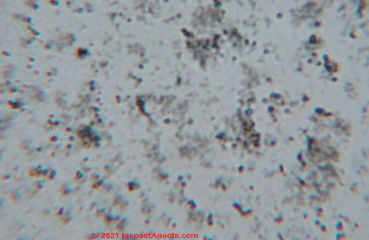 We speculate that the actual range of inhaled soot might, in the body, be easily reduced to sub-micron size.
We speculate that the actual range of inhaled soot might, in the body, be easily reduced to sub-micron size.
See details at AIRBORNE PARTICLE SIZES & IAQ
In our OPINION, testing your indoor surfaces or air for soot is probably not useful given the building history you've already reported. When you see dark sooting stains you already know these particles are present; and you already identified the source as a woodstove.
In general when we see thermal tracking stains, we look first for the source in order to address immediate safety concerns such as unsafe heating equipment or an unsafe chimney.
What about air tests to see if your ghosting stains are releasing soot into the air?
Having performed many tests of dust and debris particles on surfaces and in the air itself, I also caution that "air tests" for particles may be impressive but they're highly inaccurate. Details are
at AIRBORNE PARTICLE LEVEL VARIATIONS
If for research reasons you want to collect surface particles an easy and low-cost procedure that can work well is at
DUST SAMPLING PROCEDURE - collect gently, don't smash your particles.
alternatively see
VACUUM CASSETTE FILTER SAMPLE TESTS for DUST / MOLD
Soot Cleanup Advice
Question: how do we clean up soot from a plugged chimney?
Lots of soot became airborne when we had a plugged chimney recently due to excess soot in the stack and lack of cleaning. The soot is on the floor and basement. I read simple green or concentrated degreasers are good to use, and water, vinegar/baking soda dawn soap is not.
We would appreciate any suggestions. Anonymous by private email 2022/06/15
Moderator reply: soot cleanup methods depend on what got sooty
What we use to clean soot from surfaces depends on the surface material.
Any household cleaner works well on a hard surface.
Soot in carpets, drapes, furnishings, probably need a professional cleaner. I've found that tackling those yourself often makes the staining worse: wetting the sooty surface causes the soot particles to spread across and soak into such materials.
Sooty drywall walls and ceilings: we seal with a lacquer primer-sealer and re-paint.
Watch out: be sure to read OIL BURNER SOOT & PUFFBACKS to be sure you're not going to repeat the event.
Soot Cleaning Advice
Soot from an oil burner puffback explosion is oily and is more-difficult to clean than lighter soot deposits from a fire, wildfire, or fireplace. Most likely you'll find some items like badly-sooted carpets are beyond economical cleaning if puffback damage was severe.
For fire and smoke damage, soot can be oily and easily stain textiles and porous materials. If possible, hire a professional fire damage restoration professional.
If that isn’t feasible, try these methods recommended by the U.S. HUD for fire or smoke-damaged homes - adapted with minor edits:
- To clean soot from smooth surfaces,
skim items with the suction-only nozzle (no beater brush) of a vacuum cleaner with a HEPA (high efficiency particulate air) filter to let suction pull off the soot. - To clean dry soil and soot in carpeting,
use a HEPA vacuum with a beater brush. - Safely use a dry chemical sponge to remove light soot on drywall, wood, etc:
(sold by cleaning supply companies), rubbing alcohol, or other non-water based cleaner to wipe light soot from drywall, bare wood and other porous surfaces. - For light, dry soot on plaster walls,
avoid a water-based cleaner since it can cause stains to bleed into the wall. When there is heavy residue, wet soot, or plastic or rubber residue, plaster walls may need to be washed then sealed with a stain blocker before repainting. - Use a household cleaning detergent in water for soot deposits on hard materials like tile,
countertops, sealed wood,glass, metal and appliances. - Clean soot-covered plastics
with a mild alkali detergent to remove and neutralize possible acidic soot. Acidic soot can be activated by humidity to cause permanent staining. - Avoid scented deodorizers
that only mask smoke odor and add chemicals to the air. Clean or replace materials, repeatedly launder fabrics, and ventilate to reduce odor. If odor lingers, try wiping with vinegar or baking soda, set out activated carbon or use odor absorbing products.
Source: U.S. HUD, REBUILD HEALTHY HOMES, Guide to Post-Disaster Restoration for a safe and healthy home [PDF] U.S. Department of Housing and Urban Development (HUD)
Research on Soot Hazards in Buildings
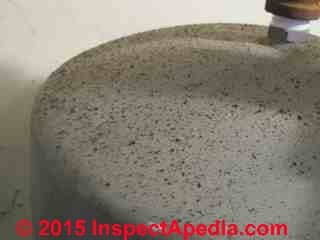 Photo: soot particles atop a water heater that was next to an oil-fired heating boiler whose oil burner was behaving badly.
Photo: soot particles atop a water heater that was next to an oil-fired heating boiler whose oil burner was behaving badly.
- AIRBORNE PARTICLE SIZES & IAQ - web article
- ASHRAE, PLANNING FRAMEWORK for PROTECTING COMMERCIAL BUILDING OCCUPANTS from SMOKE DURING WILDFIRE EVENTS [PDF] ASHRAE, retrieved 2023/06/20, original source: ashrae.org/file%20library/technical%20resources/covid-19/guidance-for-commercial-building-occupants-from-smoke-during-wildfire-events.pdf
- Bearer, Cynthia F. "Environmental health hazards: how children are different from adults." The Future of Children (1995): 11-26.
- Bolstad-Johnson, Dawn. The HIDDEN HAZARDS of FIRE SOOT [PDF] AIC News 35, no. 5 (2010): 1-5.
Excerpts:
Smoke is the result of incomplete combustion, which produces tiny particles of carbon in the air. When deposited, these particulates are identified as soot. Put simply, the particle size of smoke residue on a surface can present a respiratory hazard.
The particle size of soot is approximately 2.5 microns, a size that is associated with deep lung penetration. Particles that are approximately 10 microns or larger get trapped in the upper respiratory tract. Particles that are 5 microns or smaller can make it down to the lower lung where the gas exchange occurs in the alveoli.
In order to offer some perspective on the size of these particles, the dust you see flying in the light coming through a window is about 40 microns in size. Airborne soot present within the breathing zone of workers is too small to be seen with the naked eye and can easily be inhaled.
...
Typically, soot is representative of what has burned, but may include byproducts that at first seem unrelated to the original material. For example, hydrogen cyanide is a byproduct of burning wool. When wood burns it can produce manganese and benzene.
As many products as there are in the world, there are an equal number of byproducts produced in a fire. Each fire is different based on the contents of what has burned during the event. Organic and inorganic materials produce different types of smoke residue or soot.
These residues may be present on surfaces that conservators may be tasked with treating. Burnt organic material produces soot that is hard to see and often has a very pungent odor. This is known as protein smoke. It can discolor paints and varnishes. Protein smoke can disperse over large areas and attach itself to everything.
- Browner, Carol M. SMOG & SOOT: updating air quality standards [PDF] NIH, Public Health Reports 112, no. 5 (1997): 366.
Excerpt:
An overwhelming body of independently reviewed evidence us that the existing standards for smog and soot are not sufficient to protect the public's health with an adequate margin of safety. - Davenport, Coral, "E.P.A. Says It Will Review Rules on Soot", The New York Times, p. A21, 11 June 2021
Excerpt:
Recent scientific studies have also linked fine soot pollutionwith higher rates of death from Covid-19. Black and brown communities tend to be especially exposed to soot and other air pollution because they aer frequently located near highways, power plants, and other industrial facilities. - Eke, Ndubuisi. "Toxic soot is killing us softly." Port Harcourt Medical Journal 11, no. 1 (2017): 1-1.
- HUD, REBUILD HEALTHY HOMES, Guide to Post-Disaster Restoration for a safe and healthy home [PDF] U.S. Department of Housing and Urban Development (HUD)
- Javins, Tom, P.E., Gail Robarge, Emily Gibb Snyder, Gregory Nilsson, Steven J. Emmerich, PROTECTING BUILDING OCCUPANTS FROM SMOKE DURING WILDFIRE and PRESCRIBED BURN EVENTS [PDF] US EPA, who republished this article from ASHRAE, the ASHRAE Journal, March 2021 pp. 38-43, retrieved 2023/06/20, original source: epa.gov/sites/default/files/2021-05/documents/ashrae_journal_article_march_2021-tagged.pdf
This article contains 10 specific suggestions for protecting building occupants from wildfire smoke.
Excerpt:
ASHRAEGuideline 44P, Protecting Building Occupants from Smoke During Wildfire and Prescribed Burn Events, will provide HVAC and building measures to minimize occupant exposures and health impacts from smoke during wildfire and prescribed burn smoke events.
This column summarizes the planning framework for Guideline 44P, which is being shared by the guideline committee to provide immediate information on this pressing issue while the committee continues work on the complete guideline. - Niranjan, Rituraj, and Ashwani Kumar Thakur. "The toxicological mechanisms of environmental soot (black carbon) and carbon black: focus on oxidative stress and inflammatory pathways." Frontiers in immunology 8 (2017): 763.
Excerpt:
The environmental soot and carbon blacks (CBs) cause many diseases in humans, but their underlying mechanisms of toxicity are still poorly understood. Both are formed after the incomplete combustion of hydrocarbons but differ in their constituents and percent carbon contents.
- Shriver, Thomas E., and Gary R. Webb. "Rethinking the scope of environmental injustice: Perceptions of health hazards in a rural Native American community exposed to carbon black." Rural Sociology 74, no. 2 (2009): 270-292.
Abstract
We use in‐depth interviews, participant observation, and document analysis to examine perceptions of environmental health and justice among Native Americans in a rural Oklahoma community. Residents live near the Continental Carbon Company, which manufactures a rubber compound know as “carbon black.”
Ponca tribal members believe their respiratory problems and other health concerns are directly related to the black dust emanating from the facility, but they have been unable to validate their health claims through institutional channels.
We examine how Native American respondents interpret the environmental pollution as a threat not only to their health and well‐being but also to their sense of community.
We address the perceived pattern of institutional denial and highlight the obstacles facing an impoverished Native American community attempting to validate their environmental health claims.
...
Continue reading at WALL STAIN DIAGNOSIS - topic home, or select a topic from the closely-related articles below, or see the complete ARTICLE INDEX.
Or see these
Recommended Articles
- AIRBORNE PARTICLE SIZES & IAQ
- AIRBORNE PARTICLE SIZE TABLE
- AIR POLLUTANTS, COMMON INDOOR
- CEILING STAIN DIAGNOSIS
- CREOSOTE FIRE HAZARDS
- DUST SAMPLING PROCEDURE
- FIRE & SMOKE ODOR REMOVAL
- GAS BURNER FLAME & NOISE DEFECTS
- GAS BURNER SOOT CAUSE & CURE
- GAS BURNER PILOT LIGHT PROCEDURE
- GHOSTING DARK STREAKS or LINES: CAUSES to diagnose lines or rectangular areas of stains on walls or ceilings
- OIL BURNER SOOT & PUFFBACKS
- OZONE AIR PURIFIER WARNINGS
- SOOT at CHIMNEY TOP
- SOOT HAZARDS in BUILDINGS
- SOOT on OIL FIRED HEATING EQUIPMENT
- STAINS on INDOOR SURFACES, PHOTO GUIDE
- STAINS CANDLES FIREPLACE WOODSTOVE
- THERMAL TRACKING BRIDGING GHOSTING
Suggested citation for this web page
SOOT HAZARDS in BUILDINGS at InspectApedia.com - online encyclopedia of building & environmental inspection, testing, diagnosis, repair, & problem prevention advice.
Or see this
INDEX to RELATED ARTICLES: ARTICLE INDEX to BUILDING INDOOR AIR QUALITY IAQ
Or use the SEARCH BOX found below to Ask a Question or Search InspectApedia
Or see
INDEX to RELATED ARTICLES: ARTICLE INDEX to GAS APPLIANCES, PIPING, CONTROLS
Or use the SEARCH BOX found below to Ask a Question or Search InspectApedia
Or see
INDEX to RELATED ARTICLES: ARTICLE INDEX to HEATING SYSTEMS
Or use the SEARCH BOX found below to Ask a Question or Search InspectApedia
Ask a Question or Search InspectApedia
Try the search box just below, or if you prefer, post a question or comment in the Comments box below and we will respond promptly.
Search the InspectApedia website
Note: appearance of your Comment below may be delayed: if your comment contains an image, photograph, web link, or text that looks to the software as if it might be a web link, your posting will appear after it has been approved by a moderator. Apologies for the delay.
Only one image can be added per comment but you can post as many comments, and therefore images, as you like.
You will not receive a notification when a response to your question has been posted.
Please bookmark this page to make it easy for you to check back for our response.
IF above you see "Comment Form is loading comments..." then COMMENT BOX - countable.ca / bawkbox.com IS NOT WORKING.
In any case you are welcome to send an email directly to us at InspectApedia.com at editor@inspectApedia.com
We'll reply to you directly. Please help us help you by noting, in your email, the URL of the InspectApedia page where you wanted to comment.
Citations & References
In addition to any citations in the article above, a full list is available on request.
- In addition to citations & references found in this article, see the research citations given at the end of the related articles found at our suggested
CONTINUE READING or RECOMMENDED ARTICLES.
- Carson, Dunlop & Associates Ltd., 120 Carlton Street Suite 407, Toronto ON M5A 4K2. Tel: (416) 964-9415 1-800-268-7070 Email: info@carsondunlop.com. Alan Carson is a past president of ASHI, the American Society of Home Inspectors.
Thanks to Alan Carson and Bob Dunlop, for permission for InspectAPedia to use text excerpts from The HOME REFERENCE BOOK - the Encyclopedia of Homes and to use illustrations from The ILLUSTRATED HOME .
Carson Dunlop Associates provides extensive home inspection education and report writing material. In gratitude we provide links to tsome Carson Dunlop Associates products and services.


